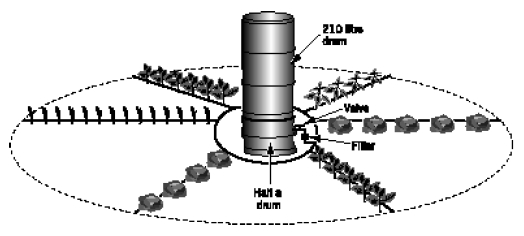Difference between revisions of "Waggon Wheel system"
From Akvopedia
(Created page with "The Waggon Wheel system. Drawing: [http://www.samsamwater.com/library.php?serie=RELMA%20Technical%20Handbook%20Series RELMA.] The Wa...") |
|||
| Line 2: | Line 2: | ||
The Waggon Wheel system was developed in South Africa by Dr Gerrie Albertse in 1995. It has been used to grow vegetables and grapes in the very harsh conditions of arid South Africa. The Waggon Wheel irrigation system uses a circular arrangement of 6 drip lines radiating out from the central reservoir drum (210 litres) — hence the name Waggon Wheel. The length of each drip line is 6 m. | The Waggon Wheel system was developed in South Africa by Dr Gerrie Albertse in 1995. It has been used to grow vegetables and grapes in the very harsh conditions of arid South Africa. The Waggon Wheel irrigation system uses a circular arrangement of 6 drip lines radiating out from the central reservoir drum (210 litres) — hence the name Waggon Wheel. The length of each drip line is 6 m. | ||
| + | |||
| + | |||
| + | ==Construction operations and maintenance== | ||
| + | '''System components'''<br> | ||
| + | |||
| + | * 210-litre drum | ||
| + | * 42 m 16 mm polyethylene pipe | ||
| + | * 7 pieces 15 mm tee connectors | ||
| + | * 1 unit 100 mm x 15 mm nipple with 2 back nuts | ||
| + | * 15 mm control valve (tap) | ||
| + | * 1.5 m 16 mm polyethylene pipes (manifold) | ||
| + | * 3.6 m 1.5 mm nylon braided string. | ||
| + | |||
| + | '''Assembly instructions'''<br> | ||
| + | |||
| + | # Drill an outlet hole on the side of the drum about 10 cm from the bottom. | ||
| + | # Install a back nut, nipple and control valve on the outlet. | ||
| + | # Cut 6 pieces each 30 cm long from a 2-m PE pipe to be used in constructing the circular manifold. | ||
| + | # Using 6 tee connectors construct a circular manifold by connecting the tee connectors to the PE pieces, as shown in the diagram. | ||
| + | # Make a platform from an old drum cut in half. | ||
| + | # Make the drip lines by cutting six 7-m lengths of 15-mm PE and mark the positions of the holes on the pipe (30 cm apart). Heat a 50-mm nail and burn a hole through both walls of the pipe. Cut 10-cm pieces of string and thread the string through the two holes. Tie a knot on each side. Close the drip line at the end by bending the pipe and tying it with a piece of wire. | ||
| + | # Connect the drip lines to the manifold and the manifold to the drum outlet. | ||
| + | |||
| + | ==Costs== | ||
| + | A typical cost of the homemade Waggon Wheel system is US$ 16 in South Africa. | ||
| + | |||
| + | ==Acknowledgements== | ||
| + | * Sijali, Isaya V. [http://www.samsamwater.com/library.php?serie=RELMA%20Technical%20Handbook%20Series DRIP IRRIGATION: Options for smallholder farmers in eastern and southern Africa.] RELMA, 2001. | ||
Revision as of 07:06, 30 May 2012

The Waggon Wheel system. Drawing: RELMA.
The Waggon Wheel system was developed in South Africa by Dr Gerrie Albertse in 1995. It has been used to grow vegetables and grapes in the very harsh conditions of arid South Africa. The Waggon Wheel irrigation system uses a circular arrangement of 6 drip lines radiating out from the central reservoir drum (210 litres) — hence the name Waggon Wheel. The length of each drip line is 6 m.
Construction operations and maintenance
System components
- 210-litre drum
- 42 m 16 mm polyethylene pipe
- 7 pieces 15 mm tee connectors
- 1 unit 100 mm x 15 mm nipple with 2 back nuts
- 15 mm control valve (tap)
- 1.5 m 16 mm polyethylene pipes (manifold)
- 3.6 m 1.5 mm nylon braided string.
Assembly instructions
- Drill an outlet hole on the side of the drum about 10 cm from the bottom.
- Install a back nut, nipple and control valve on the outlet.
- Cut 6 pieces each 30 cm long from a 2-m PE pipe to be used in constructing the circular manifold.
- Using 6 tee connectors construct a circular manifold by connecting the tee connectors to the PE pieces, as shown in the diagram.
- Make a platform from an old drum cut in half.
- Make the drip lines by cutting six 7-m lengths of 15-mm PE and mark the positions of the holes on the pipe (30 cm apart). Heat a 50-mm nail and burn a hole through both walls of the pipe. Cut 10-cm pieces of string and thread the string through the two holes. Tie a knot on each side. Close the drip line at the end by bending the pipe and tying it with a piece of wire.
- Connect the drip lines to the manifold and the manifold to the drum outlet.
Costs
A typical cost of the homemade Waggon Wheel system is US$ 16 in South Africa.
Acknowledgements
- Sijali, Isaya V. DRIP IRRIGATION: Options for smallholder farmers in eastern and southern Africa. RELMA, 2001.
